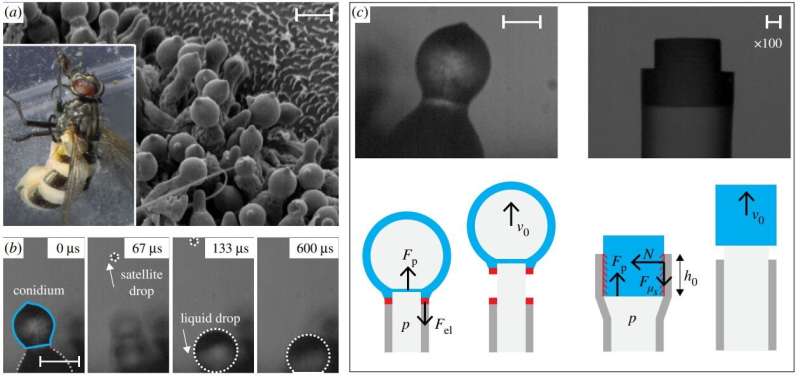October 30, 2019 report
Researchers build a biomimetic 'soft cannon' to understand how fungal spores are dispersed

A team of researchers from the Technical University of Denmark, the University of Copenhagen and Wageningen University and Research has built a tiny biomimetic 'soft cannon' to better understand how fungal spores are dispersed. In their paper published in Journal of the Royal Society Interface, the group describes building their tiny cannon and what they learned from firing it.
Entomophthora muscae is a type of fungus that survives by infecting and taking over female house flies. Once a spore lands on its skin, the fungus digs in and makes itself at home. In addition to taking over the circulatory system, the fungus also makes its way to the brain and begins controlling the behavior of the fly. The fungus survives by eating the fly from the inside out, and shortly before the fly dies, it is made to land on a nearby high point.
After that, the fungus creates stalks on the exterior of the fly that are essentially hollow tubes filled with liquid and a spore. The pressure inside the stalks builds up to a certain point, and then, at just the right moment, the liquid containing the spore is released, pushing the cargo into the air. The researchers report that the cannons fire the when a male fly, attracted to the female corpse, comes close or touches it. Upon firing, the spores make their way to the skin surface of the male, who passes it on to an unwitting healthy female during mating. In this new effort, the researchers sought to learn more about the cannon mechanism. To that end, they built themselves their own small version of it and then tested how it responded.
The team built their cannon out of a rubber-like polymer with a plug on one end. Upon filling it from the other end, they were able to increase pressure in the tube. The team tested their biomimetic cannon by firing it with different sized payloads at different amounts of pressure. They report that their tiny cannon was able to fire payloads at up to 10 meters per second. They also found that the ejection velocity slowed as the cannon got bigger, and that the optimum spore size was approximately 10 micrometers—close to the size of the natural spores—and small enough to travel on a slight breeze.
More information: Jolet de Ruiter et al. Fungal artillery of zombie flies: infectious spore dispersal using a soft water cannon, Journal of The Royal Society Interface (2019). DOI: 10.1098/rsif.2019.0448
Journal information: Journal of the Royal Society Interface
© 2019 Science X Network




















